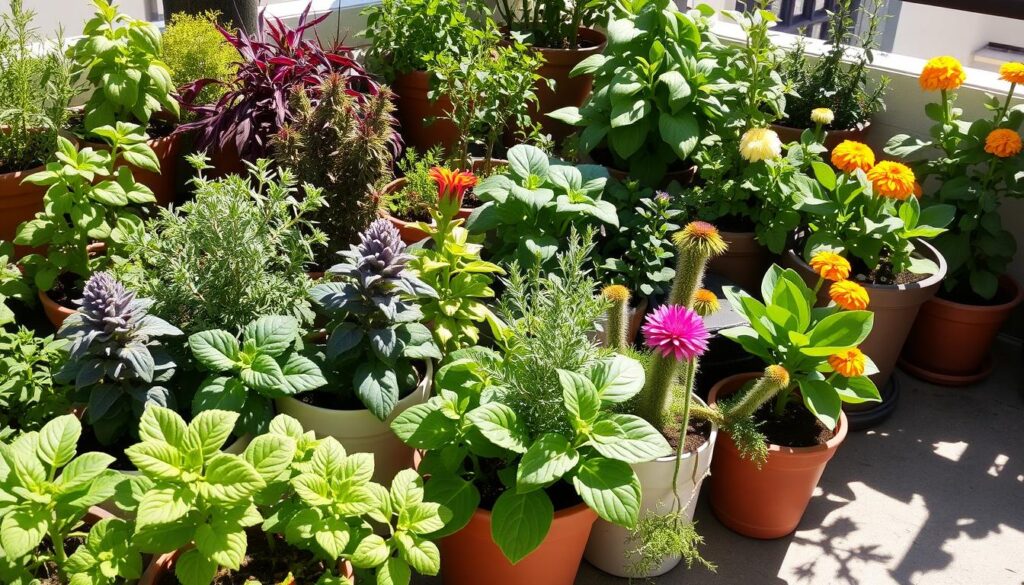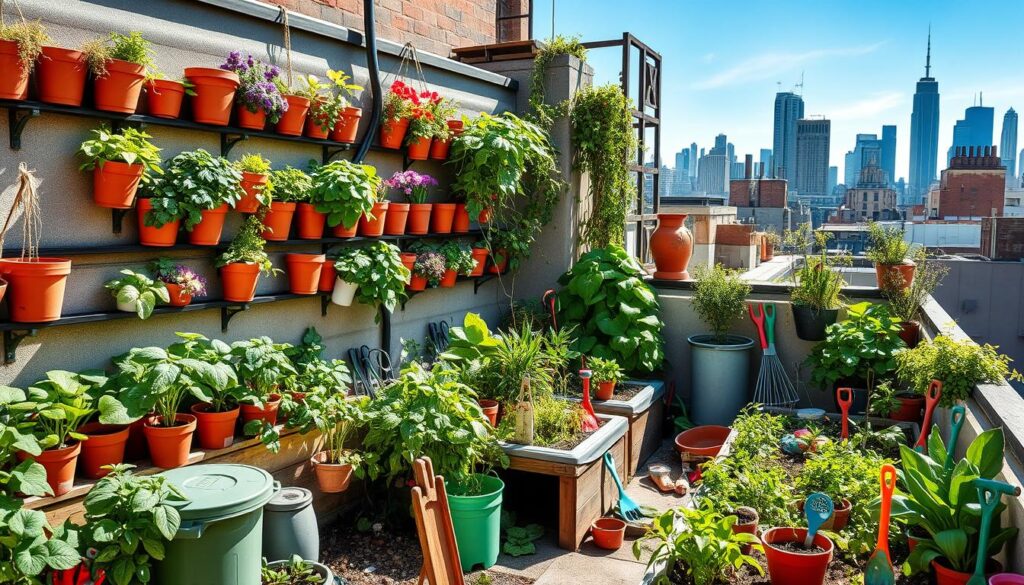Are you missing out on turning your concrete jungle into a lush garden oasis? Learn the art of urban gardening solutions that will change your view on small space gardening. Even the smallest areas can be turned into spaces for growing vibrant plants, vegetables, and herbs.
In this article, we’ll explore effective methods to improve your living space and help the environment. Whether you’re on a balcony, rooftop, or indoors, there are many ways to grow your green thumb. Make the most of your urban gardening experience.
Key Takeaways
- Urban gardening solutions can transform urban spaces into green sanctuaries.
- Small space gardening requires innovative techniques to maximize potential.
- Sustainable urban gardening promotes eco-friendly practices and improves local biodiversity.
- Choosing the right plants is crucial for successful urban gardening.
- Essential tools play a significant role in maintaining your garden efficiently.
Introduction to Urban Gardening Solutions
Urban gardening lets people in cities grow plants even when space is tight. They turn balconies, rooftops, and small backyards into green spaces. This makes cities greener and adds nature to urban areas.
There are many urban gardening ideas for everyone. Beginners can start with simple container gardens. More advanced gardeners might try hydroponics or vertical gardening to use space better. Community gardens also offer a chance to grow food together and make friends.
Studies show urban gardening improves air quality and food access. Growing plants makes cities look better and air cleaner. It also helps people get fresh food. Urban gardening promotes a green lifestyle, making cities healthier.
Benefits of Urban Gardening
Urban gardening brings many benefits to both individuals and communities. It improves air quality and boosts food security. These advantages highlight the value of sustainable gardening in cities. By using urban farming methods, we can make our environment greener and our lives healthier.
Improve Air Quality
One key benefit of urban gardening is its ability to clean the air. Plants help by taking in carbon dioxide and releasing oxygen. This makes urban areas cleaner and healthier to live in.
Studies show that green spaces in cities can greatly reduce smog. This leads to better air quality and healthier living conditions.
Increase Food Security
Urban gardens also help with food security by offering fresh, organic produce. Many cities lack stores with healthy food options. By growing their own food, people can access better nutrition.
This local food approach also cuts down on the need for long-distance food transport. It reduces carbon emissions and supports sustainable living.
Enhance Aesthetic Appeal
Urban gardening also makes cities look better. Flowers and greenery add color and beauty to neighborhoods. This boosts community pride and creates peaceful spaces.
These gardens offer places for relaxation and socializing. They improve mental health and make cities more inviting.
| Benefit | Description |
|---|---|
| Improve Air Quality | Plants absorb CO2 and release oxygen; reduces urban pollution. |
| Increase Food Security | Provides access to fresh produce; reduces transportation emissions. |
| Enhance Aesthetic Appeal | Creates green spaces; fosters community and relaxation. |
Choosing the Right Space for Your Garden
Finding the perfect spot for your urban garden is key to success. There are many great options, each with its own benefits for small gardens. Think about these spaces to find the best fit for your project.
Rooftops vs. Balconies
Rooftops and balconies get lots of sunlight, perfect for container gardens. Roof gardens can hold many plants and use vertical space. Balconies are great for herbs, veggies, and flowers, being easy to reach.
- Rooftops: Big enough for big gardens, they’re good for both looks and food.
- Balconies: Perfect for city folks, they need little setup and can use hanging planters.
Community Gardens
Community gardens are great for meeting neighbors and sharing tools. They let you grow food and build community. These gardens have many plants and resources, perfect for those with little space.
Indoor Gardening Options
Indoor gardening turns small spaces into green zones. Use window sills or hydroponics for plants all year. These setups bring fresh food and clean air indoors. Here’s how to start:
- Use natural light to help plants grow.
- Choose the right containers to avoid waterlogged soil.
| Space Type | Key Benefits | Ideal Plants |
|---|---|---|
| Rooftops | Maximized sunlight and space | Tomatoes, peppers, herbs |
| Balconies | Accessibility and functionality | Flowers, lettuce, small fruits |
| Community Gardens | Collaboration and shared resources | Varied vegetables, herbs, and flowers |
| Indoor Gardening | Year-round cultivation | Succulents, herbs, leafy greens |
Essential Tools for Urban Gardening
To make your urban garden thrive, you need the right tools. There are many tools that help you garden well. From containers to systems for plant care, knowing these tools will help you enjoy gardening.
Containers and Pots
Choosing the right containers is key to a successful garden. You can pick from pots to vertical planters. These options help you use space well, letting you grow more plants in small areas.
Soil and Fertilizers
Good soil is essential for healthy plants. Look for organic fertilizers to boost soil health. Trying different mixes for your plants can make your garden grow strong and sustainable.
Watering Systems
Good watering systems are important for keeping plants healthy. In hot cities, systems like drip irrigation or self-watering pots work well. They save water and keep plants watered. Knowing about these systems is crucial for gardening in the city.
Creative Planting Techniques
Using new ways to plant can really help with urban gardening. By using vertical, hydroponic, and container gardening, city folks can grow lots of plants in little space. These methods not only save room but also make gardening fun.
Vertical Gardening
Vertical gardening means growing plants up on walls or fences. It’s great for small gardens because it uses space well. It also makes it easier to take care of plants and keeps them healthy.
Hydroponics
Hydroponics grows plants in a special liquid instead of soil. It’s perfect for small spaces, like apartments. It lets you grow plants all year and try out different kinds, making urban farming fun.
Container Gardening
Container gardening lets you get creative with your garden. You can use pots, buckets, or even old things to make your garden. It’s great for small spaces because you can move things around and control the plants’ environment.
| Technique | Space Requirements | Plant Variety | Maintenance Level |
|---|---|---|---|
| Vertical Gardening | Minimal ground space | Vines, small fruits | Moderate |
| Hydroponics | Very limited | Leafy greens, herbs | High |
| Container Gardening | Flexible | All types | Low to moderate |
These creative gardening methods make small spaces into beautiful gardens. With the right techniques, anyone can enjoy gardening in the city.
Selecting the Right Plants for Your Space
Choosing the right plants for urban gardening is key, especially when space is tight. Opt for compact, high-yield varieties to get the most out of your garden. Here are some tips and plant suggestions for different spaces.
Best Vegetables for Small Spaces
In small urban gardens, some vegetables are better than others. Dwarf varieties of the following do great:
- Dwarf Tomatoes
- Bell Peppers
- Leafy Greens such as Spinach and Lettuce
These veggies grow well in containers and give you fresh produce all season. They’re perfect for urban gardens.
Flower Options for Urban Gardens
Flowers can make urban spaces look better. Choose low-maintenance types like:
- Petunias
- Marigolds
- Zinnias
These flowers add color and need little care. They’re great for urban gardens.
Herbs That Thrive Indoors
Indoor gardening is perfect for growing fresh herbs. The following are popular and easy to care for:
- Basil
- Mint
- Chives
Having these herbs adds flavor to your cooking and greenery to your home. It’s a great way to use urban gardening resources.

| Plant Type | Best Varieties | Growing Conditions |
|---|---|---|
| Vegetables | Dwarf Tomatoes, Bell Peppers, Leafy Greens | Containers, Full Sun |
| Flowers | Petunias, Marigolds, Zinnias | Containers, Partial Shade |
| Herbs | Basil, Mint, Chives | Indoor Pots, Bright Light |
Sustainable Practices in Urban Gardening
Using sustainable practices in urban gardening helps both your garden and the environment. These methods raise awareness in the community and encourage green living.
Composting
Composting turns kitchen waste and yard clippings into soil food. It cuts down on landfill waste and makes soil better. For DIY gardeners, making a compost bin is easy and rewarding.
Rainwater Harvesting
Rainwater harvesting collects rain for watering plants. It saves water and money. Gardening solutions that use rainwater help protect our water sources.
Organic Pest Control
Organic pest control keeps pests away without chemicals. It uses beneficial bugs, planting friends, and natural sprays. These methods make gardens healthy and safe for the planet.
| Practice | Benefits | DIY Tips |
|---|---|---|
| Composting | Reduces waste, enriches soil | Create a bin with kitchen scraps |
| Rainwater Harvesting | Conserves water, reduces costs | Use barrels to collect roof runoff |
| Organic Pest Control | Enhances plant health, eco-friendly | Introduce ladybugs or use neem oil |
Overcoming Common Urban Gardening Challenges
Urban gardening comes with its own set of challenges. We’ll share tips to help you tackle these issues. You’ll learn how to overcome common problems and find solutions for your urban garden.
Managing Limited Space
Many gardeners in cities face the challenge of small spaces. Vertical gardening is a great way to grow a lot in little space. Container gardening also helps by making it easy to move plants around.
Using these methods is key to making the most of small spaces.
Dealing with Pollution
Pollution in cities can harm plants. Growing air-purifying plants can help clean the air. Knowing what pollutants are in your area helps choose the best plants.
By following these tips, you can grow healthier plants despite pollution.
Combatting Local Wildlife
Wildlife in cities can damage gardens. Building barriers around your garden is a good solution. Picking plants that pests don’t like can also help.

| Challenge | Urban Gardening Solutions | Tips |
|---|---|---|
| Limited Space | Vertical gardening, container gardening | Maximize yield with creative design |
| Pollution | Air-purifying plants | Research local pollutants before planting |
| Local Wildlife | Barriers, pest-resistant plants | Choose plants that deter pests naturally |
Connecting with the Urban Gardening Community
Getting involved with the urban gardening community can really boost your gardening skills. It’s a chance to swap tips, share tools, and learn from others who love gardening as much as you do. This network of gardeners can help you grow your garden better.
Joining Local Gardening Groups
Local gardening groups are a fantastic way to dive into the urban gardening scene. These groups meet up to talk about gardening, share advice, and work on projects together. Being part of a group means you get to use great resources and make friends who love gardening just like you.
Participating in Workshops
Workshops are a great way to learn by doing. Community centers and local groups often host these classes. You can learn about composting, growing veggies, and more. Workshops help you understand gardening better and apply what you learn in your own garden.
Sharing Resources Online
The internet is full of places to connect with gardeners. Online forums, social media, and gardening apps are perfect for sharing ideas and resources. These spaces let you ask for advice, find new ideas, and join in on discussions that help everyone.
| Type of Connection | Description | Benefits |
|---|---|---|
| Local Gardening Groups | Meet regularly to share knowledge and collaborate. | Networking and support; idea exchange. |
| Workshops | Hands-on learning experiences offered by local experts. | Skill acquisition and practical knowledge. |
| Online Sharing | Utilizing digital platforms for advice and ideas. | Access to vast resources and community building. |
Conclusion: Start Your Urban Gardening Journey Today!
Starting your urban gardening journey is more than a personal project. It’s a way to help your community and the environment. You can turn even the smallest area into a lush garden with the right solutions.
Urban gardening isn’t just about looks; it’s about being green and improving your life. Growing your own food means fresher, healthier meals. Plus, it’s good for the planet when you use eco-friendly gardening methods.
It’s time to get started. Whether you’re new or experienced, you can make a green space that’s all your own. Use the tips from this article to pick the best methods for you. Begin your gardening adventure today and enjoy the many rewards it brings!
FAQ
What are some effective urban gardening solutions for small spaces?
For small spaces, use vertical gardening, container gardening, and rooftop or balcony spaces. These methods use every inch of space. They help you grow more in less area.
How can I ensure a sustainable urban garden?
To have a sustainable garden, compost and harvest rainwater. Use organic pest control and choose native plants. These plants need less water and care, helping local ecosystems.
What are some great urban gardening tips for beginners?
Beginners should start with easy plants like herbs and leafy greens. Use good soil and fertilizer. Make sure containers drain well. Learn about your climate and sunlight to pick the right plants.
Can I grow vegetables in containers?
Yes! Tomatoes, peppers, and greens grow well in containers. Make sure containers are big enough and have holes for water.
What should I consider when choosing the right space for my urban garden?
Think about sunlight, water access, and plant types. Rooftops get more sun, while community gardens are great for bigger projects and meeting people.
How can I overcome the challenges of urban gardening?
Use space-saving methods like vertical gardening. Choose plants that clean the air. Use barriers to keep wildlife out.
Are there online resources for learning more about urban gardening?
Yes! There are many online resources like forums, blogs, and social media groups. Sites like UrbanGardeningSolutions.org and the American Community Gardening Association offer tips and connections.
What are the benefits of urban gardening for city dwellers?
Urban gardening improves air quality and gives you fresh produce. It makes your space look better and brings people together. It also helps your mental health by providing green spaces.


